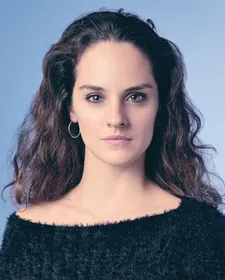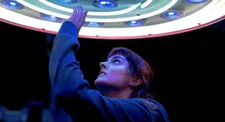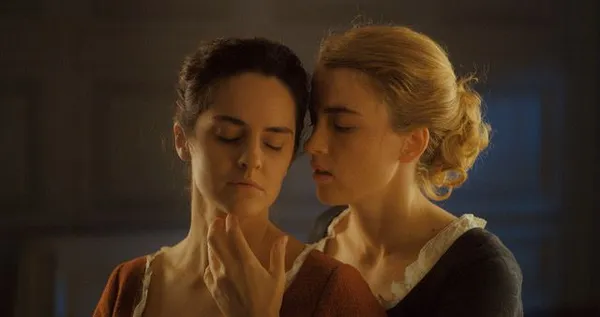She describes herself as “a bit of a dreamer” but Noémie Merlant (co-star with Adèle Haenel in Portrait Of A Lady On Fire, one of the hottest French films of this awards season) could never in her wildest imaginings predicted how her career could have taken off.
 |
| Noémie Merlant : "“I am not sure the film could have been made by a man - or it would have been very different.” Photo: UniFrance |
She is now touted as one of the most promising actors of her generation, with awards and nominations aplenty including a nomination with Haenel for Best Actress in the Césars, the French Oscars, due to be announced on Friday (28 February), among ten nods for the production including Best Film and Best Director for Céline Sciamma. Portrait Of A Lady On Fire took off after the Cannes Film Festival last year when it won the Queer Palm (the first film directed by a woman to win the award) as well as the Best Screenplay accolade.
In a quiet moment of reflection in a Parisian hotel de luxe during an interview at the Rendez-vous with French Cinema at the start of this year, Merlant recalls her first reading of her role as the painter Marianne, who is hired to paint the portrait of Haenel’s Héloïse, a woman stifled by the demands of 18th century society.
“I had been given the script to read before I met Céline. I was knocked out by the narrative, the strength of passion in the writing and the strength off the love between these two women that already was there on the page: it was not just the words but the indication of the silences, the looks, the mounting desire - it was revelation. There was a lot of intimacy there too which definitely speaks to a lot of women. I had the feeling that this kind of relationship had not been seen on screen and I sensed this would be an important film. I met Céline for the first time at the audition, and she sat there opposite me and played the part of Héloïse which I discovered is part of the way she works.”
Merlant (31) had seen all the director’s previous films such as Water Lilies, Girlhood, and Tomboy. “Although this one is very different and in some ways unexpected, it was precisely because of the sensibility you feel in all her films that I wanted to meet her,” says Merlant who found the director created “an environment of kindness and respect and equality.”
As the youthful dreamer she had no particular ambitions to act. She possessed no cinema culture in her background, discovering the world through watching films and series on television. “But I had a lively imagination and thought up stories and situations in my head,” she smiles.
 |
| Portrait Of A Lady On Fire |
She drifted in to modelling “because it was a fairly easy way to make money, and also to have flexibility in the way I could use my time. And the pay helped to fund my acting classes at the Cours Florent acting school in Paris. I was also able to travel and to learn English. Finally, though, it wasn’t the kind of job that appealed to me. I guess I liked going to exotic places, but I didn’t like being perceived as ‘an object.’”
Her first foray into cinema was shooting as a director a three-minute short film Je Suis Une Biche (I Am A Pet), made for the Nikon Film Festival in 2017. “I loved the experience. It was tough but I needed to do it to have an insight into what acting is all about. It is so much part of who you are: your voice, your body, the way you breathe, and your ideas. So I plan to continue as an actor but also to pursue directing at the same time.” She admires the careers of such actor directors as Emmanuelle Bercot and Mélanie Laurent.
Her turn playing Sonia in Marie-Castille Mention-Schaar’s Heaven Will Wait earned a César nomination. Another formative encounters was with youthful first-time director Nathan Ambrosioni who was 17 and embarking on his first feature, Paper Flags, when they met. He offered her a role as the younger sister of an ex-convict (played by Guillaume Gouix) who bursts into her life. “I thought the role was really promising and after having talked to him I thought it was even more appealing: he seemed so mature in his ideas and his view of cinema. He knew what he wanted to do and we just seemed to get on.”
Merlant loves the process of filming, but detests the preparation or rehearsals beforehand. “I think a lot about the role, but if I have to rehearse in any way I prefer to do it at home on my own or in conversation with the directors. I like to build a character little by little. If you rehearse too much it will be picked up by the camera. I need a live reaction to provoke me. In rehearsals you always feel constrained and want to hold back to keep something in reserve for the scene itself. I have difficulty balancing that,” she suggests.
 |
| Portrait Of A Lady On Fire |
Although Portrait Of A Lady On Fire is a period film, Merlant felt its contemporary resonances. She continues: “It’s really very modern story in a costume drama - the tale of a love between two women, of artistic creation and mutual consent. You’re playing around with emotions such as frustration, imagination, and desire. It is exciting to push the boundaries - for instance in the sex scene or the scene of the abortion or the depiction of menstruation - these are things that are not usually shown on screen. And at that time in the 18th century there were many women painters, but they seem to have been completely written out of history and society. The whole weight that was put on women at the time comes automatically with those costumes and corsets. The characters, generally, are rather reserved in the first part of the film, and little by little, we’re going to break that and enter their intimacy. We’re going to see them laugh, joke, have conversations, discuss womanhood and art. Little by little, there is a truth that comes out of all this accumulated restraint. I think that came rather naturally because Céline was really trying to lead us to a most sincere and truthful place. It was the same for the bodies. Little by little, the costumes are removed or forgotten, we show something else with our bodies because the characters finally let themselves go.
“I am not sure the film could have been made by a man - or it would have been very different. I think you would have to have a female perspective to write this kind of story. Obviously there were some men on the crew but I definitely would say there was a softness in the atmosphere on the set and obviously being of the same sex helped in many ways because you did not need to explain things. I have worked more often with women directors than men - it was not a deliberate choice, but it just happened.”
 |
| Noémie Merlant in Jumbo: "There’s a great deal of contemplation in the relationship.” Photo: Sundance Institute |
She’s involved in another, if rather different, passionate affair in her upcoming film, Zoé Wittock’s Jumbo, shown in Sundance’s World Cinema Dramatic Competition and now in Berlin's Generation section - this time with a fair ground attraction. The theme of objectum sexuality – the sexual attraction focused on inanimate objects – provided her with a distinct challenge. “Initially the problem was to find sincerity,” explains Merlant. “It’s ultimately always a challenge to create a relationship, and I found that it could actually be easier with an object because my character was projecting so much of herself onto this silent partner. She falls in love with its material existence, colour and nature. There’s a great deal of contemplation in the relationship. It’s something very peaceful.”
She has also managed to complete a 26-minute short, Shakira, about a young gypsy woman who tries to integrate into mainstream French society. ““I made it with a few friends from a gypsy community on the outskirts of Paris I met a few years ago. We don’t see enough films involving this community. Gypsies in France, and all around the world, suffer a great deal of racism and prejudice. I wanted to share what I was seeing.”
She continued the gypsy theme in Mi Iubita (which means My Love in Romany), a self-financed micro-budget production shot in Romania with a small crew and cast. Merlant herself also plays the female lead, who is about to get married and goes on a pre-nuptial trip with a group of girlfriends to Romania, where she meets a young gypsy man, played by Gimi-Nicolae Covaci, who has travelled from France to see his family. Her character becomes trapped in a house and needs his help to escape.
“I decided to write it at the last moment and shot it last summer. It was a quick shoot over 16 days, with no producer and no money. Now I am looking for producer to help me for the second part of the process with post-production. I decided just to go and make it. I was not convinced I could do it but everyone was very motivated. And we had total freedom.”
Portrait Of A Lady On Fire now on release in the US / UK and Ireland through Curzon from 28 February.






















